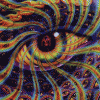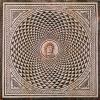Well damn, Crow, that blows away anything I was thinking about answering those questions with. I would just note that in terms of TAG anyway, I've had this idea that synchrony, phase, and coherence all refer to the goal of training two (or more) signals of different frequency to rise and fall together in amplitude, and that coherence is a measure of how in-phase these signals are (I think of stereo speakers playing bass when I think of phase: if you process the bass in an audio signal to playback in mono, your woofers move in phase with each other and produce a much more powerful thump, but if wired in stereo then they move out of phase with one another and the bass effect is muddier and more muffled sounding).
Viewed another way, if you look at brainwaves in a 2-dimensional rendering on x/y axes as sine waves, and you stack one on top of the other (the wave can either chart the actual frequency of the signal, or it could chart the fluctuations in amplitude--brain waves pulse regularly in strength, or they appear to anyway when you view them in an EEG histogram), assuming the peaks and troughs are of equal size, if you slide one of the waves left or right, you can make the peaks and troughs line up with one another (in phase) or one wave can peak before or after the other one (out of phase), and if you time it so the peak of one correlates with the trough of the other then they can negate each other (this is the principle behind noise-canceling headphones and acoustic devices). I don't know if any of that is correct, but that's the model I've been working with. Looks like a mess when I try to put it in writing, I admit.
What I'm even less clear on is how TAG determines these metrics. I've been teaching myself how to read Bioexplorer designs from the Signal Diagram window, but I'm not very deep into it yet so I haven't learned where to look to see how data is being measured and computed (I assume it's not actually all that difficult). But anyway, you're measuring activity in 2 bands (like Alpha and Theta) at 2 sites (like Pz and Fz). Amplitude of each frequency is represented on one gauge for each. My assumption has been that (in this case) Alpha and Theta are being measured at both sites, and that each gauge is presenting an average amplitude. But on reflection it seems just as likely that (for example) Alpha is measured at Fz, Theta is measured at Pz, and the TAG design sets about helping the subject synchronize the activity in those 2 bands from those 2 sites.
I had this idea that brain waves are generated locally, i.e. Theta at Pz is generated at Pz, Alpha at Oz is generated at Oz, etc, but in reality these rhythms--or Alpha anyway, from what I gather--are generated deep inside the brain, and at any given site the neurons (?) are either resonating with that inner oscillation or tied up with some local task. So at any given time, Alpha measured anywhere across the brain should all be at the same frequency and in coherence (?god I feel like such a dumbass trying to puzzle this out)--is synchrony then a question of amplitude? that is, do we say Alpha at Oz and Pz are in sync if they are resonating at roughly equal amplitude? and that by training synchrony across sites in a single frequency, we're training those sites into a state of dominant activity at that frequency? Does anybody understand this? I thought I had some vague idea of what was going on, but honestly I can see I need to do some more reading.
So forget that for now. At a fundamental level I really don't understand a lot of what EEG measures. What the hell actually takes place in a "phase reset?" I'm going to go climb a tree and think about bananas for a half hour or so.
Getting back to what I was talking about in an earlier post, my idea was that it would be good to work with simpler 4-channel sync designs just to give the brain some training at increasing synchrony at a single frequency across a wide area. The idea came from this fragment that Crow quoted from that entropy design manual: "Training alpha or theta synchrony between the 4 channels can aid in the communication between sites and help with balancing the entropy levels between sites. There is an emerging body of evidence that the synchronous gamma activity necessary for learning and binding information is triggered by synchronous theta activity." IOW it looks as though there's evidence that simply training up Theta synchrony automatically increases Gamma sync, whether you're actively trying to promote it or not. And this also seems to state pretty clearly that just training synchrony in either Theta or Alpha boosts communication, just like training up resting state network hubs in the brain using TAG sync.
So it seems to me training 4-ch Alpha sync and Theta sync separately might be good practice or exercise for TAG Sync, especially if you're like me and having a hard time producing synchrony with just the TAG design.
Another reason I'm interested in working with Alpha Sync is because this is the focus of two very different but apparently profound approaches that have gotten quite famous. One is Jim Hardt's work at Biocybernaut Institute (Crowsteam links them above), and the other is Les Fehmi's Open Focus work which I've invoked many times in EEG discussions here and elsewhere. Fehmi made some kind of device that splits a single EEG channel 5 ways to monitor and train up Alpha synchrony across 5 sites (I found out the sites once but lost the information :( but at least I know the info is out there somewhere to be found again--and it's not in Fehmi's books, either). Hardt otoh designed his system to teach how to guide yourself into a state of heightened Alpha synchrony--the feedback tells you if you're there or not--and apparently it's hard as hell to learn, and takes a week of 12-14 hour days to get the knack.
Both these methods conform to findings that advanced meditators produce high synchronous Alpha starting at the back of the head and, at deeper states and with greater meditative ability, creeping around the sides and up the midline. Both methods claim to produce all kinds of benefits in equanimity and cognitive function in day-to-day life.
Coupling this with the bit from the entropy design manual, I wonder if Gamma isn't implicated in here somewhere too. At any rate there are a handful of synchrony designs in my TLC pack (including one called CON2C that appears to be designed to do almost exactly the same thing TAG Sync does), and since I've found all my other TLC designs to be easy to use and reliably effective, I'm going to work with these also and see if it doesn't improve my results. If I can get through my daily study stack with enough time leftover today, I'll try 4-Ch Alpha on the midline.
One other thought on the ego that I've been meaning to mention here: it is strongly correlated with P4. I ran into a section on this at the brain-trainer FAQs and they say that a high level of Alpha activity at P4 is correlated with a sense of ego dissolution, and/or oneness with the universe. That's not in connection with anything in particular, but if it's a priority for you to increase your capacity for nondual awareness, you might consider making P4 a part of your TAG routine.
It's been a slow week for EEG training for me--I think I must be experiencing some kind of study fatigue because I've only managed to get through my allotted course work twice this week; normally it can be slow but I always finish. Many days even if I do finish, it's already so late that I don't have any time left over for EEG. Hope I can get that turned around because I really want to work with some of these TLC designs now, and I was just starting to get a good daily habit with TAG right before my productivity crashed.
How are you guys doing?
Hey hza!  This synchrony business is pretty confusing I admit :D I might be mistaken in my interpretation, but it is the best one I have been able to come up with so far at least. Maybe we are both right, I also think that we are training the signals of different frequencies to rise and fall together in amplitude, like when we are training alpha and theta at the same time. I am not sure if theta and alpha can be in synchrony, since they are different frequencies their rhythms are different. But if you use the definition "adjustment of rhythms of self-sustained periodic oscillators due to their weak interaction" then maybe there can be synchronization between alpha and theta since they could at least have an influence on each others rhythms through their interaction.
This synchrony business is pretty confusing I admit :D I might be mistaken in my interpretation, but it is the best one I have been able to come up with so far at least. Maybe we are both right, I also think that we are training the signals of different frequencies to rise and fall together in amplitude, like when we are training alpha and theta at the same time. I am not sure if theta and alpha can be in synchrony, since they are different frequencies their rhythms are different. But if you use the definition "adjustment of rhythms of self-sustained periodic oscillators due to their weak interaction" then maybe there can be synchronization between alpha and theta since they could at least have an influence on each others rhythms through their interaction.
Maybe music is a good analogy to this, where frequencies are different, but can interact to form chords which are composites of different frequencies. There could be a lot of interactions between brainwaves in a similar way.
We do know that there is cross-frequency and phase-amplitude couplings which seem to indicate something like this! Douglas Dailey sometimes talks about the brain being somewhat like a drum, you have to tune each individual tether of the drum for the drum to produce the sounds you want when you hit it. In this way tuning individual frequencies are like tuning the tethers, and taken as a whole they contribute to a whole-brain pattern of activity.
My thinking about neural synchrony is influenced by this paper: http://www.ncbi.nlm....pubmed/23236202
It was quite a long time ago now since I read it so I dont remember everything exactly, but I think the main finding was:
"The findings presented here offer direct experimental evidence for the long hypothesized dependence of EEG amplitude on the synchrony of neuronal sources rather than simply the strength of their activation. More specifically, we demonstrate how neural synchrony “amplifies” the contribution of localized neural activity (LFP) into the EEG, thus explaining the amplitude differences often observed between intracranial and surface measurements of neural activity."
So I think what this means is that when we measure brainwaves, the change in the amplitude that we observe is in part because of changes in the strength of activation, but also because of changes in neural synchrony. Neural synchrony meaning that larger groups of neurons have organized their firing patterns at a particular frequency, so the increase in amplitude then is because of an increased number of cells firing at that frequency.
I am still a bit confused by this so maybe I should go read up more on synchrony, but my thinking is generally this:
-A certain % of the amplitude change is because of neural synchrony
-When you combine the measurements of 2 or more sites, like Fz and Pz, you amplify this effect, my thinking is that if you are watching a signal like we use in TAG Sync, which combines two sites, then any large increase in this signal will most likely be because of neural synchrony, because any change that is only local to one electrode will not be sufficient to raise the signal to its top say 20%. If you get a large increase in the signal, I think it means that both electrodes are contributing to this, and if they are then this must be because of neural synchrony between them (indicating a long-range connection)
Its just an interpretation I have made so far from what I have read, I will have to look into it some more  .
.
I think you are right about brainwaves and phase, my thinking is that when you combine 2 sites like Fz and Pz, if the signals are out of phase, they will tend to cancel each other out and amplify each other when in phase. If they are in phase then the peaks and troughs will coincide and produce higher amplitudes.
The way the TAG Sync design works is to first filter the raw signal from each channel through a 1-60hz ish hz filter and then the signals are combined, after that they are fed into different filters for each reward. So the rewards are always the combined signal of both Fz and Pz.
I am not sure about exactly where the brainwaves come from, but I know for example that the theta rhythm is said to originate in the limbic system, more specifically the hippocampus but I think other places in the brain also produce this rhythm so it seems to be distributed also. The alpha rhythm I think is more related to the cerebral cortex. In general I think the brainwaves follow the evolution of the human brain, delta is related to more primitive structures and is also the dominant rhythm for reptiles, theta is the dominant rhythm for a lot of mammals and alpha I think is an adult human dominant brainwave so I guess in general the older the brain structure the more delta will be involved in that structure.
Phase resets I think are part of the normal cycling of neurons where they form temporary groups of neurons that will cooperate to solve a particular problem/computation in the brain, and when that is solved they phase reset, which means they change their firing pattern and go back to an idling state, ready to be recruited once again into a larger network, when recruited they will phase-lock which means they will fire together with other neurons in the group, I think this is very much related to neural synchrony. When you see a lot of desynchronization in the EEG I think more neurons are in idling states, and thus not connected to larger groups of neurons. When you see synchrony it means groups of neurons are recruited together at that frequency.
I think you are right about theta sync leading to gamma sync, I think that is because of phase-amplitude coupling and cross-frequency coupling in general. I think what theta does is to start establishing a long-distance connection and gamma "finishes the job" by binding separate networks together, this is called spike-timing dependent neuroplasticity. It may be why using TAG Sync can be such a joyous experience, because you are experiencing the integration of your neural networks  .
.
Les Fehmis invention I think is just an electrode that is separated to go to 5 different places. I think it might be possible to buy one and use it with TAG Sync. Thats what Douglas told me when I asked him about increasing the number of channels in the design, he said I could just use a split-electrode like Les Fehmi.
That P4 may be connected to the ego is interesting, I am still confused because in the Entropic Brain article they link alpha desynchronization to ego-dissolution whereas Les Fehmi and the biocybernaut institute claim the opposite, that alpha synchrony is related to ego-dissolution. Maybe they mean the same thing but are measuring in different ways or using their concepts differently? In any case it always seems to be the parietal lobe, Pz or P4 and alpha seems to be involved so I guess all we can do is to keep experimenting and seeing what kind of effects we can get from training!
I am really happy about how my training is going  I feel like my mind is stabilizing into meditative states quite a lot and I feel more and more at peace and clear-minded.
I feel like my mind is stabilizing into meditative states quite a lot and I feel more and more at peace and clear-minded.
I have constructed a neurofeedback routine that looks like this:
1. TAG Sync 4-channels T3-T4-C3-C4 - to increase the communication and integration between my left and right hemispheres
2. TAG Sync 1-channel T3-T4 - Infra-low frequency and delta - to increase the differentiation and help my hemispheres also work more independently of each other
3. TAG Sync 4-channels T3-T4-C3-C4 - again to balance out the differentiation of nr 2.
4. Entropy 4-channels T3-T4-C3-C4 - I made this protocol from modifying a 2 channel protocol that I found - I use this to increase differentiation
And then I repeat, I just started it so I have just run the ILF and entropy once so far in this cycle. My intention is to both increase integration and differentiation, this may seem paradoxical but I think both are important for healthy brain function since they both contribute to increasing the complexity of the brain, which I think is beneficial.
In addition to this I am somewhat obsessed with constructing a similar training protocol to the Biocybernaut Alpha One training  . I am collecting any information I can find on these protocols and compiling a document that I will use to create a bioexplorer design for this. They dont reveal all of their methods but I have been able to find quite a lot, enough to construct a working protocol I think. I am having some problems though. For example, in Alpha One you do 2 minutes of eyes closed auditory only feedback, followed by 8 seconds eyes open looking at a visual display of your result over the last 2 minute epoch. This is difficult to create in bioexplorer but I have some ideas on how to solve it, I think I can create similar visual representations, and then I can probably find a timer program online that can beep at 2 minute intervals with a pleasant sound, and then you open your eyes and look at the display. If I set the visual displays to average their data over 2 minutes then they will basicly show your the average data for that epoch...
. I am collecting any information I can find on these protocols and compiling a document that I will use to create a bioexplorer design for this. They dont reveal all of their methods but I have been able to find quite a lot, enough to construct a working protocol I think. I am having some problems though. For example, in Alpha One you do 2 minutes of eyes closed auditory only feedback, followed by 8 seconds eyes open looking at a visual display of your result over the last 2 minute epoch. This is difficult to create in bioexplorer but I have some ideas on how to solve it, I think I can create similar visual representations, and then I can probably find a timer program online that can beep at 2 minute intervals with a pleasant sound, and then you open your eyes and look at the display. If I set the visual displays to average their data over 2 minutes then they will basicly show your the average data for that epoch...
Another problem is that they use 4 audio feedback sounds, 1 for each channel (they use O1,O2,C3,C4 in alpha one I believe), and each sound has its own speaker. In bioexplorer you can only choose left or right speaker so I havent thought of a way to do 4 speakers yet...
Thats basicly where I am at in my neurofeedback journey right now  .
.































 This topic is locked
This topic is locked



















